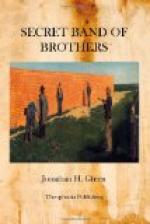[Illustration: Literature Lottery BY AUTHORITY OF THE STATE OF KENTUCKY Class No. 205 Com Nos 10 48 75
This Ticket will entitle the holder to one QUARTER of such Prize as may be drawn to its Numbers, if demanded within twelve months after the Drawing. Subject to a deduction of Fifteen per cent: Payable forty days after the Drawing.
For A. BASSFORD & CO., Managers.
#Covington, 1841. QUARTER.#
[This plate represents a lottery ticket with the numbers placed upon it. The numbers seen upon its face are of the same order as those found upon every ticket when sold, and are used to designate one ticket from another, and by comparing them with the numbers at the head of any of those packages of combinations, on another page, you will see the manner in which they are arranged, and the great advantage in favor of the managers.]]
FALLACY OF LOTTERIES AS A MEANS OF REVENUE.
We are indebted for the following exposition to our moral friend, Capt. John Maginn, of New York city.
“Although they may produce, by the various deceptive allurements which they hold forth, a temporary influx into the treasury of the state, yet the prostration of industry, the formation of idle habits, intemperance and various other vices, have invariably been the consequences wherever they have been introduced. No farther evidence of this position is requisite than the fact that in England, where many of the common necessaries of life are heavily taxed, it has been satisfactorily ascertained from observation, that for several days preceding the drawing of a lottery, the consumption of such articles was very materially diminished. It is moreover equally true, that a very small proportion of the tax actually paid, through the purchase of lottery tickets, is available to the state: by far the greater part being absorbed in the expenses, profits, &c., of managers and venders.”
INSURING NUMBERS, OR POLICY DEALING.
As the system of insuring numbers is at present practised to a fearful extent in this city, and as its votaries are mostly the ignorant and unthinking portion of the community, we proceed to give a plain matter-of-fact investigation of the chances.
There being on the day of drawing a certain number of tickets in the wheel, out of which a particular number of them are to be drawn, it follows that there are so many chances to one against a given number being drawn as the number which are to be drawn are contained in the entire number of tickets in the wheel. To illustrate this practically, suppose you would insure the payment of $100 upon the event of a certain number being drawn from the lottery wheel to-day; suppose it is a 78 number lottery, and that 12 ballots are to be drawn; the chance then is evidently 78/12, or 6.5 to 1 that you lose: accordingly, in order to make the chances equal, you must pay 100/6.5, or




